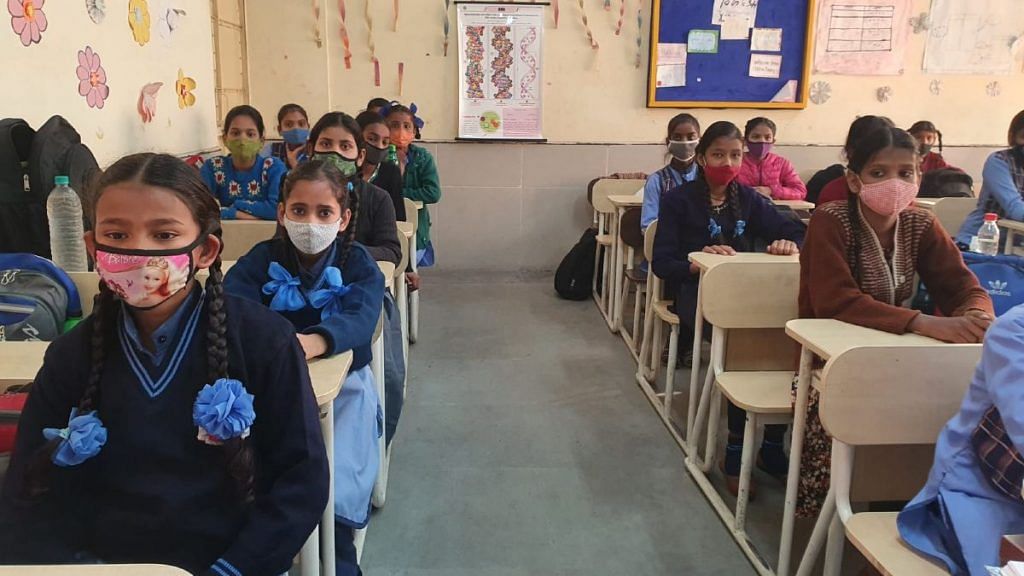New Delhi: Identify students from each grade who have dropped out of school and locate them by April, states and Union territories have been told by the Central government, ThePrint has learnt.
The Union Ministry of Education, in the first week of February, also shared a detailed road map with states, aiming to mitigate Covid pandemic induced learning loss among school students — a thorough survey of reading skills among children, pairing government and private schools in clusters and schemes to help students get back to classroom learning are also on the cards.
With schools closed for nearly two years, students have suffered major learning loss. A study conducted by Azim Premji University in 2021 found that on an average, “Ninety-two per cent children have lost at least one specific language ability and 82 per cent have lost at least one specific mathematical ability from the previous year across classes 2 to 6.”
According to the Ministry of Education document, a copy of which is with ThePrint, the states and UTs have been given time-bound tasks to be carried out throughout the academic year 2022-23. The tasks start with identifying drop-outs and getting them back into the school system.
Starting from March to April, states have been asked to first conduct an Oral Reading Fluency (ORF) survey among children to determine where they stand in terms of reading skills. The states will also be given a financial support of Rs 20 lakh per state for conducting the exercise.
“lt is proposed to have an assessment in Oral Reading Fluency for establishing minimum reading benchmarks in different Indian languages for children at Grade 3 level and assessing performance against the same, so as to take remedial steps,” said the document addressed to all states and UTs sent by the joint secretary, Ministry of Education, Maneesh Garg.
In the same period — March to April — states have to identify out-of-school children (who have never been in the school system) as well as students who dropped out due to the Covid induced lockdown and other reasons.
The government has so far not shared any data on the number of children who have dropped out of schools during the last two years of school closure. This exercise is expected to give concrete data to both Central and state governments.
Also read: Include past years in student assessment, recover learning loss: Teachers in Premji Univ. study
Clusters of private schools, KVs, JNVs
After identifying drop-outs, the states are supposed to form clusters or pairs of private schools with Kendriya Vidyalayas (KVs) or Jawahar Navodaya Vidyalayas (JNVs), both run by the Central government, so that the schools can learn from each other and provide better education. This is supposed to be done between April and May.
Apart from this, the ministry has also assigned certain tasks that are supposed to be carried throughout the year — all schools are expected to conduct a parent-teacher meeting every month, throughout the school year. Schools are also expected to prepare a weekly plan of learning outcomes to be achieved by students.
In the meantime, schools are expected to address the learning gap by using various interventional tools designed by the government and National Council of Educational Research and Training (NCERT).
The NCERT has designed a bridge course for those out-of-school children who are in the pre-school to Class 8 category, to help them get into the formal school system.
Package to aid students to get back on track
Apart from this, the Central government has come up with the Learning Enhancement Programme (LEP), a scheme that is meant to help students get back to normal learning from classrooms.
Under this scheme, students will be given remedial teaching resources like worksheets/workbooks, age-appropriate story books, supplementary learning materials and individualised learning interventions. Students will also be provided with a fixed amount of money as part of the aid package.
“States and UTs may prepare grade wise material and ensure their delivery to the students. All children must be provided this package in the beginning of the academic session of 2022-23. Financial support of Rs 500 per student for all students at upper primary and secondary level will be provided,” the document read.
The Central government also carried out a National Achievement Survey (NAS) in November last year to identify learning gaps among students. The results of the survey will also be used by states to take remedial action for students.
(This report has been updated to correct the percentage of children who have lost at least one specific language ability. It should be 92 per cent, not two per cent. The error is regretted.)
(Edited by Saikat Niyogi)
Also read: 1 year of lost learning will take years to recoup, says India study urging reopening of schools
